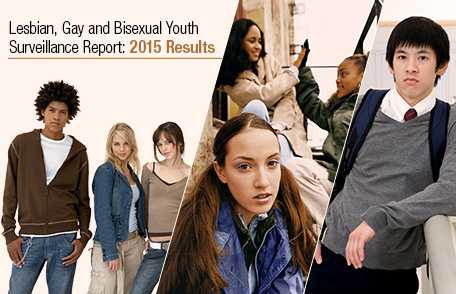LGB Student Health Risks
 CDC releases new national data on health risk behaviors among lesbian, gay and bisexual (LGB) high school students. The study highlights the need for coordinated action to improve the health and well-being of LGB students.
CDC releases new national data on health risk behaviors among lesbian, gay and bisexual (LGB) high school students. The study highlights the need for coordinated action to improve the health and well-being of LGB students.
Lesbian, gay and bisexual (LGB) teens are part of every community and come from all walks of life. They are diverse, representing all races, ethnicities, socioeconomic statuses, and parts of the country. While many LGB teens thrive during adolescence, stigma, discrimination, and other factors put them at increased risk for negative health and life outcomes. Coordinated action by schools and communities is needed to protect LGB teens and address the health risks they face.
New National Survey Results
New data published in CDC’s Morbidity and Mortality Weekly Report offers insight into the health risks of LGB high school students. The report, “Sexual Identity, Sex of Sexual Contacts, and Health-related Behaviors Among Students in Grades 9-12—United States and Selected Sites, 2015,” includes the first national estimates of more than 100 health risk behaviors— including sexual risk behaviors; violence; and tobacco, alcohol, and other drug use—that put LGB teens at risk. Findings from the report show that LGB students experience substantially higher levels of physical and sexual violence and bullying than non-LGB students. The report is available on the Healthy Youth Web site.

While many LGB teens thrive during adolescence, stigma, discrimination, and other factors put them at increased risk for negative health and life outcomes.
LGB Students Are at Risk for Negative Health Outcomes
While many LGB students transition from adolescence to adulthood successfully, others struggle as a result of challenges such as stigma, discrimination, family disapproval, social rejection and isolation, and violence. More specifically, when compared to their heterosexual peers, LGB students are significantly more likely to report:
- Being physically forced to have sex (18 percent LGB vs.5 percent heterosexual)
- Experiencing sexual dating violence (23 percent LGB vs.9 percent heterosexual)
- Experiencing physical dating violence (18 percent LGB vs.8 percent heterosexual)
- Being bullied at school or online (at school:34 percent LGB vs.19 percent heterosexual; online: 28 percent LGB vs. 14 percent heterosexual)
What CDC Is Doing to Support the Health and Well-being of LGB Students
For LGB students to thrive in their schools and communities, they need to feel socially, emotionally, and physically safe and supported. CDC works with other federal agencies, national nongovernmental organizations, and state and local departments of education, health, and social services to support the health and well-being of LGB students by —
- Developing policies and practices that support the establishment of safe and supportive environments for all students, including LGB students.
- Facilitating access to education, health care, and evidence-based interventions designed to address priority health-risk behaviors among LGB students.
- Implementing programs and providing training for those who work with LGB students to better understand needs and services.
- Summarizing and applying survey results to increase the effectiveness of interventions and programs for LGB teens.
- Providing funding and technical assistance to develop, implement, and evaluate interventions that reduce health risk behaviors and promote healthy practices among LGB students.
- Monitoring the impact of broad policy and programmatic interventions on the health-related behaviors of LGB students.
CDC calls for accelerated action to protect the health and well-being of these young people. Everyone has a role to play. Families, schools, health and community organizations, and teens must work together to address these health- and safety-related behaviors and help LGB students thrive.
- Page last reviewed: August 11, 2016
- Page last updated: September 8, 2016
- Content source:
- National Center for HIV/AIDS, Viral Hepatitis, STD, and TB Prevention
- Page maintained by: Office of the Associate Director for Communication, Digital Media Branch, Division of Public Affairs




 ShareCompartir
ShareCompartir